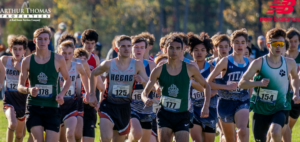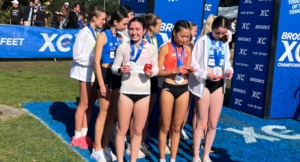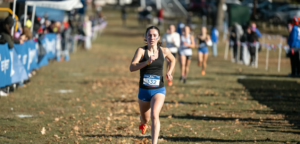By Mike Smith
As distance runners, the end of school means summer training for a fall cross country season. With our current situation, and the question of returning to school or  school via remote learning, this cross country season hangs in the balance. Those of us in the coaching community have been pondering IF we are back in buildings in the fall, HOW do we pull off a fall cross country season. While the final decisions will come down to the governor, the Department of Education, the various school districts, and the NHIAA, it doesn’t hurt to try to “envision” what cross country will look like this fall.
school via remote learning, this cross country season hangs in the balance. Those of us in the coaching community have been pondering IF we are back in buildings in the fall, HOW do we pull off a fall cross country season. While the final decisions will come down to the governor, the Department of Education, the various school districts, and the NHIAA, it doesn’t hurt to try to “envision” what cross country will look like this fall.
Many various institutions have developed guidelines on the appropriate protocol on “return to play” in sports. The National Federation of High Schools that govern all high school sports has developed protocol focused on daily health screenings and small cohort groups to help insure the health of the all involved. USA Track and Field also has similar guidelines that oversee those athletes that participate in that side of the sport. And we’ve been assured if our students return to school, there will be protocol in place to protect them while in the school district’s care.
We all recognize that it’s the co-mingling that is common at a cross country meet that creates the greatest hurdle. Recording names, standing on the start line, locker room and bathroom facilities are all things that are necessary for a meet and provide our greatest challenges. The question is, can we figure out ways to make those things work so we can have a cross country season.
There are a couple ways to deal with the start line issue. First and foremost would be to limit entries into meets to reduce the total participants. This is tough on the bigger programs with lots of kids. If you establish a “travel squad”, there is certainly less incentive for those who don’t make it on that. You could rotate your team through those traveling squad rosters, but your true varsity then wouldn’t get the racing they are accustomed to.
For sure there would have to be some changes. Coaches might need to get a little creative and take on more responsibility for these kids that don’t inhabit the varsity roster spots. At York HS in Illinois, Joe Newton used to get 120 kids out for cross country. Not able to take all his kids to a meet, they would have inter squad developmental meets with scoring and awards for performance. Maybe schools with large teams would need to network to offer races for the additional personnel on their team. While this might not be ideal and might mean more work for the coaching staffs, it would allow a reasonable season to progress.
 Also regarding the start line, if we kept the number of entrants (teams and individuals) smaller, there would be less starting line pressure and crowding. Probably not a big deal for weekday meets but certainly a different detail for Invitationals. Commentating for the likes of the Oyster River Invite, without the ability to “add” more space to the start line, there is no way to host that many schools without doing something more creative. Three possibilities to address these types of issues could involve starting “boxes” rather than starting line boxes. If there were separated boxes the teams came out of, spread out differently than on the start line, this could accommodate more teams. Figuring out how to randomize the box assignments and finding equity among box pavement would be a challenge, but at least it would be racing.
Also regarding the start line, if we kept the number of entrants (teams and individuals) smaller, there would be less starting line pressure and crowding. Probably not a big deal for weekday meets but certainly a different detail for Invitationals. Commentating for the likes of the Oyster River Invite, without the ability to “add” more space to the start line, there is no way to host that many schools without doing something more creative. Three possibilities to address these types of issues could involve starting “boxes” rather than starting line boxes. If there were separated boxes the teams came out of, spread out differently than on the start line, this could accommodate more teams. Figuring out how to randomize the box assignments and finding equity among box pavement would be a challenge, but at least it would be racing.
Another possibility could be to use a nordic style race start, where racers go out in “waves,” a specified amount of time generally with the fastest racers going out last. “Winners” would be based on time, rather than the first person across the line. Another wave start idea might be to send off varsity squads one member at a time from the starting box in reverse order at a predetermined period of time, say every ten seconds, going from seventh man down to first man.
And another thought would be in order to deal with races with lots of teams would be to run the races in different sections with different winners. At some of the biggest invites in the college setting, like Paul Short and Nuttycombe, they have multiple races over the same course and the winner of those sections are the winner of those sections. Say the winner of the “blue” race or something. That means more winners and some missed head to head competition, but it allows the races to happen with safety in mind.
In order to record finishes, lots of times we utilize a “chute” to funnel the athletes to the timer/recorder to ensure we get the timing and scoring correct. This will obviously not work. At the State Championships we’ve gotten away from the funnel, relying on chip timing with the athletes running right through the finish area. While there tends to be a “choke point” with the exit of the finish area needing to be continuously cleared out, there are ways we can work that issue out.
obviously not work. At the State Championships we’ve gotten away from the funnel, relying on chip timing with the athletes running right through the finish area. While there tends to be a “choke point” with the exit of the finish area needing to be continuously cleared out, there are ways we can work that issue out.
Without chip timing things get a little tougher. One of the ways I’ve collected finishing time and place for smaller events (like our fundraising race we’ve done) is to have every contestant’s name and info filled out on a mailing label. In this instance each racer would be given an index card with their finishing position on it. The coaches would hold onto the mailing labels, collect the cards from their athletes and assign place on the individuals mailing label. The coach then can turn in the sheet of mailing labels to the recorder so they can compile the results and assign times to each performance. I’m sure there are other solutions out there that would work as well based on what someone has done in the past.
Locker room and bathroom facilities probably provide the biggest challenge to hosting a meet. Having athletes congregating around the bathrooms while they wait for their turn is problematic on it’s own right, never mind when we need to be as cautious as we do now. Other than more portapotties, and maybe assigned times for teams to use the locker rooms if needed. For cross country this might be less of an issue than other sports.
Certainly other concerns revolve around busing, spectators, crowning of champions, but when we get down to it, what’s the most important part? It’s the competition, it’s the opportunity to evaluate all the hard work throughout the season, not the specific results or the celebration of those results.
Editor’s Note: This week the NHIAA will be releasing their guidelines specific to cross country on the NHIAA website. We will provide a link as well. Based on these guidelines, schools should make adjustments to schedules. The good news as we publish this post, is the fact planning is taking place. If we as a state can continue to safely social distance, even with the reopening of schools, the kids could have a cross country season!












One Response
On the wave starts I would suggest sending the fastest runners first. If you send the slowest runners first everybody will tend to bunch up towards the end the course and finish line area. With the fastest runners going first they spread out more.